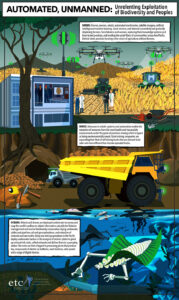As we face species’ extinction resulting from destruction of natural habitats, unabated expansion of industrial agriculture, wanton use of chemical pesticides, and pollution aggravated by climate change, industry actors are pushing for digital technologies, hailing them as a panacea for all development challenges that the planet is facing. Policy makers tend to push for “precision” digital technologies, including robots, drones and sensors, to address the challenges in biodiversity, the environment and even climate change. The dangerous drawback is, by minimizing human judgment, traditional knowledge and lived experiences, these technology systems tend to undermine people’s ability to nurture ecosystems.
The promise of “precision”
The goal of “precision” – the condition of being exact or accurate in farming, aquaculture, livestock, forestry and environmental conservation – is being peddled as the main selling point for adoption of digital tools, in particular robots, drones and sensors, to address the challenges in biodiversity, the environment and even climate change. Precision systems incorporate the use of sensors, satellite data, unmanned tractors and aerial drones for monitoring, alongside the deployment of robots and remote tracking, with the aim of maximizing efficiency, including potential ecological efficiency. While removing the need for human labor is part of the formula to reduce costs and ostensibly improve efficiency, the goal of minimizing or even eliminating human judgment, traditional knowledge and lived experiences is often left unsaid.
Precision agriculture, for example, involves acquiring and processing large amounts of site-specific data on crop and animal health, weather, soils, and pests, and applying those data through artificial intelligence and algorithms to automate farming decisions and activities. Drones or unmanned aerial vehicles equipped with radar and other sensing cameras have now joined the farmers’ fleet along with tractors, harvesters and aerial crop-dusters that have been a part of industrial agriculture systems for decades. In China, drones have been classified as farm machinery since 2017. Agricultural giant Cargill announced in 2015 that it is deploying drones on palm plantations in Indonesia to track water, soil, and other variables to boost productivity and monitor compliance with requirements for ‘sustainable palm oil’ production.
While precision agriculture systems are still emerging in most parts of Asia-Pacific, it is already apparent that a mature roll-out of digital-driven farming could have significant implications on the intensity of agricultural operations, land use and biodiversity. Proponents of precision agriculture boast of its ability to more precisely target the use of agrochemicals, nutrients and water, thus reducing the burden of toxic chemicals by moving away from broad spraying, and conserving water and other inputs as a major boon for biodiversity conservation. Those claims, however, have been challenged on the basis of flawed algorithms and sensor errors, and apply only to large farm operations that can afford to use digital tools and in areas where digital connectivity exists and can support digitalized operations.
The vision of precision farming is mirrored in precision aquaculture and fisheries involving satellite-based monitoring of fish stocks in specific parts of the oceans, as well as the use of underwater and floating drones, and fishing robots capable of detecting and harvesting specific fish species with greater efficiency, theoretically reducing by-catch. These technologies could have a dramatic impact on ocean ecosystems, fish stocks and marine biodiversity. Efficient robotic harvesting of ocean life in the high seas could aggravate the loss of marine biodiversity, as most fishing grounds worldwide are already depleted. While improved understanding of ocean and forest health, as well as fish and forest carbon stocks, has resulted from the increased availability of remote sensing technologies such as Light Detection and Ranging (LIDAR), newer automation technologies may massively intensify the commercial footprint on oceans and forests that are essential to planetary health.
Reaching hostile and inaccessible environments
Robots, drones and sensors are also being promoted to tackle environmental and biodiversity challenges in inaccessible terrain and ecosystems. Robots are deployed underwater to survey and map the world’s seafloors, only 20% of which have been accurately mapped so far. Australia has piloted sensor and submersible robots known as COTSBOT to try to manage the outbreak of crown-of-thorns starfish (COTS), a spiky and poisonous starfish that strangles corals in the Great Barrier Reef, as well as in Japan, the Philippines and Vanuatu. Data gathered by submersible robots from deep waters are valuable for fisheries management and marine biodiversity conservation, as well as for laying underwater cables and pipelines and for minerals, oil and gas exploration.
Advances in automation have also enabled the extraction of resources from the most hostile and inaccessible environments, such as deep underground and in ocean beds, while serving the industry narrative that precision mining is environmentally sound and safe. Giant mining company Rio Tinto has been expanding its fleet of self-driving trucks at its mining sites across the world. At its Pilbara mining site in western Australia, one-quarter of the iron ore is hauled by autonomous trucks, which the company claims are safer than human-operated trucks. Human drivers may not be needed at mining sites, but the extraction of minerals and all its associated harm to biodiversity will continue.
As automation enables the expansion of extractive industries, serious concerns over the impacts of deep-sea mining on marine biodiversity, ocean chemistry and fishing grounds have reverberated in affected territories. Deep-sea mining companies that operate in Papua New Guinea’s waters and extract sulphide from the margins of tectonic plates are using underwater tractors to grind up mineral-rich rocks, collect the minerals, and take them to a pumping station for delivery to a ship that takes the rocks to China for processing. There are projects to mine iron sands off the coast of New Zealand using massive siphoning robots, and ongoing government-sponsored research in South Korea, Japan and China exploring how to dredge manganese nodules from the deep sea with robots. These minerals are critical elements in industrial production, including the manufacturing of digital tools. Drones are used to explore old mines and caverns, to seek out minerals by feeding video and sonar images that are used to create detailed 3D maps of the surrounding area.
Replacing species?
As bee colonies crash globally, tiny ‘robot bees’, which are actually mini-drones, are being developed in Japan to transport pollen between flowers, to enable cross-pollination and address the domino effects of declining bee populations on ecosystems. Australian researchers are developing smart drones, fitted with artificial neural networks to recognize vegetation that can be “trained” to survey crop health and status by moving in for a close view to establish whether a field needs water, fertilizer or pesticides. These could also track insect populations.
To increase forest cover, drones are being designed to map out an area for efficient planting, and to drop germinated seedpods at a rate of one per second, for a maximum of 100,000 units a day. A British startup, BioCarbon Engineering, that provides “ecosystem restoration” services, is working in collaboration with the French drone manufacturer Parrot to deploy small fleets of drones to replant and restore forests that have been stripped of trees by industrial-scale deforestation. The company aims to plant one billion trees per year through aerial reforestation, and will work in Sri Lanka, Myanmar and Thailand to counter the proliferation of monoculture and deforestation. Drone-assisted mass reforestation risks obscuring issues related to the control and ownership of lands and indigenous territories targeted for these operations.
“Eyes in the sky and in the ground”: who owns, who benefits?
Asia-Pacific has the largest overall spending on drones and robotics systems globally. East Asia in particular has a long history with automation, especially robots, boosted by economies built on manufacturing computers and electronic microchips for decades, which allowed them to become leaders in robotic technologies today. The drone industry is dominated by Chinese companies. XAG, a company based in Guangzhou and founded in 2007, is one of the world’s leading manufacturers of drones and specializes in a wide array of farm robots, or ag bots. It has forged a strategic partnership with Bayer AgroSciences to promote the adoption and distribution of XAG’s unmanned aerial systems for efficient spraying of Bayer’s agrochemicals among small-scale farmers in Southeast Asia and Pakistan. They also entered into a cross-industry alliance in Japan to provide integrated agricultural solutions that combine drones, digital farming and agrochemical formulation, catering to the country’s aging rural population and shrinking agricultural labor force.
The world’s leading drone manufacturer, Shenzen-based Dajiang Innovations (DJI), controls more than two-thirds of the global market for consumer and enterprise drones. DJI has an agriculture division that focuses on drones for aerial spraying of pesticides, as well as mapping and capturing aerial images used to design solutions with proprietary technologies built into specially designed farm drones. DJI has a partnership with Dow Chemicals (now called Corteva AgriScience after it merged with DuPont) since 2017, and with Syngenta (owned by ChemChina, which in turn was acquired by Sinochem) since 2018, to test its drones for the aerial application of proprietary pesticides for these agrochemical giants. DJI and XAG together control 80% of the drone market in China, where an estimated 50,000 drones are used in large industrial farms as well as in smaller farms, as the sector increasingly faces a shortage of labor due to the aging rural population.
The vision of aggregating massive amounts of data generated from farmlands and plantations to provide better insight into local, regional, and global biodiversity trends, improve models, and flag hot spots for conservation, requires extensive infrastructure, facilities and resources. These are mostly absent in rural areas in developing countries in the region, especially those consisting of smallholder farmers and marginalized farming communities. The collection of detailed data on the quality of land, profitability and yield makes these territories more prone to resource grabs by powerful actors, who now have technological means of accessing data from areas that were previously too remote.
Robots, people and biodiversity
Early experiments with drones on plantations raise questions, beyond biodiversity implications, concerning human and workers’ rights, as well as legal challenges. Even when such systems are used to enforce questionable and narrow so-called ‘sustainability’ criteria, they may do so at the expense of social, cultural, and economic rights. As with previous generations of agricultural technologies, questions over ownership and access to the technology itself have structural roots. These proprietary technologies prescribe farming practices, erode farmers’ autonomy and undermine their wisdom. If an artificial intelligence algorithm makes farming or land use decisions that badly harm biodiversity, who is liable for the damage? Is it the farmer, the machine producer, or the data company? There are questions around conflicts of interest, as algorithms promote the products of the proponent company rather than the interests of farmers and the cause of biodiversity.
Human rights defenders may be concerned that the drones that monitor crop health and spray pesticides are also tools for surveillance that may impact agricultural workers’ rights, leading to displacement from their jobs and increased workplace injuries. The drones that now enable the application of internet of things (IoT) in real-time environmental monitoring in remote areas where mobile networks are insufficient, could also be used by state agencies to obtain and relay security-related information to authorities in politically volatile areas such as Tibet.
The manufacturing of digital technologies has adverse impacts on the environment, as data centers where all the data collected is stored and processed are energy intensive and require water for cooling the servers and machines. Producing the semiconductors in digital devices requires immense amounts of water. The extraction of metals and rare earth elements for the production of batteries and cells is displacing indigenous communities, polluting waterways and damaging ecosystems.
As the biodiversity COP comes to a close, the hype around robots, drones and sensor technologies is unraveling. Instead of fixing the problems, these technologies represent a threat to biodiversity, the environment and the climate, and undermine people’s ability to nurture ecosystems.


